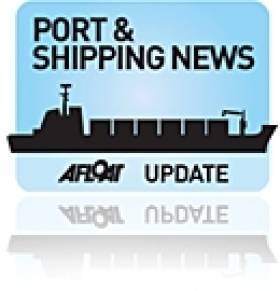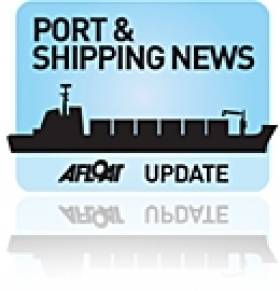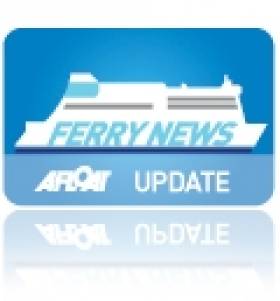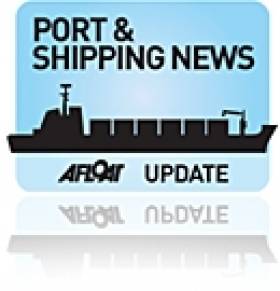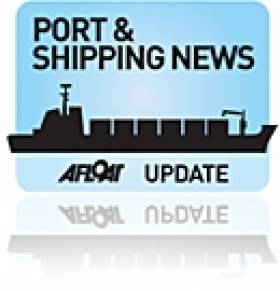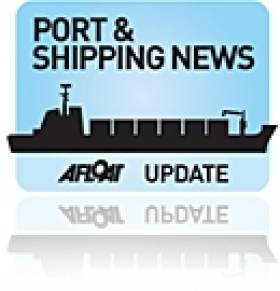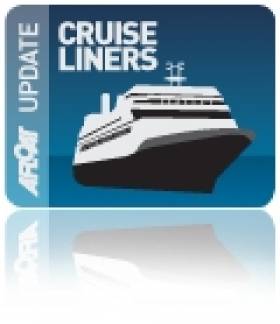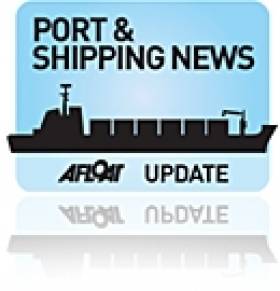Displaying items by tag: Irish ports
Record Tonnage for Belfast Harbour
#PORTS & SHIPPING – Figures released by Belfast Harbour for the year 2011 show that tonnage rose by 7% to a record 17.644m tonnes. The increase for last year was driven by strong performances in break-bulk and ro-ro (freight vehicles) and in the dry-bulk sector.
Break-bulk products jumped 23% to 332,000 tonnes. In particular, steel and steel coil traffic doubled in 2011 compared with 2010 reflecting improved activity in Northern Ireland's engineering manufacturing sector, while the number of freight vehicles using the port rose by 14%.
Dry-bulk, which includes items such as aggregates and agri-food related products, exceeded four million tonnes for the first time in the port's history.
There was a record year for stone exports, up 13% to one million tonnes, reflecting on-going road maintenance and construction projects in the UK and Europe.
Other notable performers in the sector included scrap metal (up 8%) and salt (up 82%), driven by last winter's 'Big Freeze' and according to the port, they expect similar conditions this year.
The Timber Traders and Days of Old Irish Sea Shipping Companies
#PORTS & SHIPPING- The general dry-cargo vessel, Red Duchess berthed at Ardrishaig on Scotland's west coast at Loch Fyne today, after completion of a voyage from Waterford, writes Jehan Ashmore.
The 1969-built coaster rounded the Hook Head Lighthouse yesterday around noon, having departed Belview on Waterford Estuary. She is engaged on the Irish Sea timber trade, which have been the mainstay of the cruiser stern-vessel's career (see PHOTO).This feature maybe commonplace among yachting craft, yet it is an increasing rare feature, to be found on commercial ships these days.
Her builders were Bodewes Hoogezand Scheepswerf, Bergum of The Netherlands, though the veteran vessel received a modernisation programme in 1995. In addition to the 1,285grt Red Duchess, her fleetmate Red Baroness (1979/964grt) is also actively employed on the same trade.
Each vessel has a single 80m box-hold which can also handle coal, fertiliser, salt and stone. The UK flagged vessels are owned and managed by Coast Lines Shipping based in Midleton, Co. Cork which was established in 1981. For photos of the fleet and technical details, click HERE.
The name of the Irish shipping company revives the similarly named Coast Lines which was synonymous with the British & Irish Steam Packet Co. Ltd otherwise known as B+I Line. By 1917 the Coast Lines group operated seven Irish shipping companies and held all the shares in B+I Line.
The group also had a half interest in David MacBrayne, which was together acquired in the same year by Lord Kylsant's Royal Mail Steam Packet. It was during the Kylsant period that one of their vessels, the 696 ton Lochfyne served David MacBrayne. The Kylsant shipping empire collapsed and Coast Lines regained independence in 1935.
It is apt to have these historical associations as successors to David MacBrayne, now Caledonian MacBrayne (CalMac) are Scotland's largest island ferry network which includes the Loch Fyne ferry (PHOTO) route of Portavadie-Tarbert with the remote location of Ardrishaig further up the Loch.
By 1965 Coast Lines sold their British & Irish (including the associated City of Cork Co.) to the Irish Government and the remaining part of the company was purchased by P&O in 1971. This marked an end of era, with the names of several Irish Sea freight and ferry operators slipping away.
As for Coast Lines Shipping, which was established in 1981, both Red Duchess and Red Baroness are on a time charter arrangement with JST Services. The Ayr-based company provide an integrated shipping, handling and road haulage timber business in addition to the carriage of other cargoes.
Asides serving Ardrishaig, the red-hulled vessels call to their adopted homeport of Ayr, Campbeltown and Sandbank. In addition they call to Troon, where both coasters are registered (see PHOTO). From these ports they sail to Irish ports, in particular Derry, Youghal and Passage West, a privately-owned wharf in the centre of Cork Harbour.
Timber products can include logs, which are loaded by a grabber as depicted in this PHOTO taken at Passage West. The facility also deals in scrap-metal cargo, where a mounting pile is clearly evident on the quayside, awaiting to be disposed for export.
- Shipping
- Irish ports
- irish sea
- Red Duchess
- Coast Lines
- Hook Head Lighthouse
- Caledonian MacBrayne
- B&I Line
- Ports & Shipping news
- timber
- British & Irish Steam Packet Co
- Coast Lines Group
- Coast Lines Shipping Ltd
- JST Services
- Belview Waterford
- Red Baroness
- Irish Sea shortsea coasters
- Irish Sea fshipping companies
- CalMac
- Royal Mail Steam Packet
- Irish Sea coasters
- Irish Sea short sea shipping
- Loch Fyne Scotland
- David MacBrayne
- Passage West Cork Harbour
- Cork Harbour
- PortavadieTarbert
- MV Isle of Cumbrae
Rosslare Europort to Host Irish Ports Conference
This year's Irish Ports Conference is to be hosted by Rosslare Europort on behalf of the Irish Port Association (IPA) and is to take place in Wexford on 30th September.
The event is the only one of its kind in Ireland this year where senior representatives from short-sea users, carriers, ports, logistics providers and the whole range of service providers meet to debate the topical issues of the day.
In addition the full-day conference provides those to network and explore further business opportunities and will culminate with the IPA's conference banquet.
The south-eastern ferry-port is to host delegates in the Ferrycarrig Hotel, just outside Wexford. For further information on booking and a (PDF) programme of the day visit the Rosslare Europort website by clicking HERE
Port and Shipping Volumes Show Second Quarter Slowdown
Below is a list of figures for each transport mode based for the second quarter of 2011.
•Lift-on/Lift-off (lo/lo) trades remained static at 0%.
•Roll-on/Roll-off (ro/ro) export traffic was down by 1%.
•Dry bulk volumes increased by 5%,
•Break bulk volumes were down by 6%
•The Tanker/Liquid bulk market was down 6%.
For more in-depth analysis of each freight-transport mode issued by the IMDO and accompanied by graphic charts click HERE.
Varadkar Warns of No Bail-Out to State-Owned Ports
In the report it was noted that there are too many ports and that the sector would benefit from a rationalisation of ownership and management structures. The decision which will be made over the next few months not only concerns the fate of the capital port but also the following state-owned ports: Dun Laoghaire, Waterford, Drogheda, Dundalk, Cork, Shannon Foynes, Wicklow, New Ross and Galway.
Mr Varadkar also warned that state money wouldn't be made available to bolster ports' balance sheets. "Where port companies are not successful, there will no bailouts and there will be no state aid. "It just isn't possible for the Government in the situation it's in to offer that," he said.
"Where smaller ports find themselves unable to continue operations, amalgamations or transfers to local authorities will be the preferred option."
On the issue of selling Dublin Port the company's chief executive Mr. Eamon O'Reilly who has cited previously that the port should not be sold as a private operator would not have the same incentive to invest as they would be focusing on generating returns.
As for the masterplan, he emphasised that the port would need to double its capacity so to handle the expected trade levels by 2040. He conceded the masterplan will cause some controversy but said the port has "great potential" to facilitate economic growth and make Dublin a better city to live in.
The McCarthy Report on Seaport Recommendations
The McCarthy Report: Recommendations on Seaports and Port Industry Structure reviews statistical and port data analysis based from the Irish Maritime Development Office (IMDO) financial analysis of the ports sector in 2010.
To read in greater detail the main conclusions and recommendations click here.
Check the latest ports and shipping news
First Cruise-Caller of the Year
Onboard the ship which caters mostly for the UK market, asides the interior facilities there are the outdoor leisure amenities located on the Lounge Deck which has two jacuzzis and an exercise pool. There is also a large swimming pool and weather permitting a poolside buffet is also available at meal times. In addition a circular pool is located on the Marque Deck.
She alongside sister Black Watch belong to a four-ship fleet of the Norwegian owned company. Boudicca was built in 1973 and for many years served as Royal Viking Star as part of a trio of German built sisters for Royal Viking Line. The 205m long vessel underwent her last major refit in 2006.
Boudicca will remain berthed in Dublin's Alexandra Basin until she sets sail later this afternoon for the short overnight cruise-leg to Liverpool.
Last year Dublin Port handled 88 cruisecalls and this number of cruise-callers is to be closely repeated in 2011. Overall there will be over 200 cruise calls with around half a million passengers and crew scheduled to visit ports and anchorage locations throughout the island of Ireland. The cruise sector business is estimated to generate €60m to both the northern and southern economies.
IMDO Release Third Quarter Shipping Figures
The latest figures announced by the Irish Maritime Development Office (IMDO) has revealed that the volume of goods passing through Irish ports increased across all the main shipping segments during the 3rd quarter of 2010 compared to the same period last year.
Exports of container were up 12%, roll-on/roll-off volumes on Ireland – UK routes is up 3%, dry bulk volumes up 40%, and liquid bulk up 19%.
Containersized traffic shipped through ROI ports recorded a quarter-on-quarter volume growth for the 3rd quarter 2010 up 4% to 218,377 twenty equivalent units (TEU). This was primarily as a result of strong export demand, which rose by 12% in the last quarter.
This sector is characterized by export traffic to USA and Asia largely influenced by the multinational chemical and pharmaceutical industries and also established indigenous Irish exporting companies. The other factor contributing to the aggregate rise was the increase in container imports during this period. This was also the first quarter-on-quarter growth in import volumes since the beginning of 2009.
Roll-on/roll-off (ro/ro) traffic to the UK from ROI ports continued to make a steady recovery up 3% for the 3rd quarter which is consistent with overall figures for the 9 months from Jan – Sept period which is up 3%, to 568,833 units. The ro/ro segment is largely weighted towards services to and from the UK which remains our largest trading partner.
In the dry bulk trade, traffic through all Irish Ports continued to recover some of the large volume losses experienced in 2009 and is up 40% for the 3rd quarter compared to the same period last year and 26% for the first 9 months of 2010. Part of the rise is attributed to strong global demand for ore and mineral products such as alumina, while domestic demand in the agricultural sector experienced a rise in imports of grains, feeds and fertilizers. While the overall picture is positive; the main volume gains are distributed to the larger ports with some of the smaller regional ports still in negative territory.
Break bulk volumes of construction related products fell again in the third quarter, bringing the total decline for the third quarter to -10%. Between 2008 and 2010 over 700,000 tonnes of break bulk commodities have been lost from the market. Importantly the fall off in volumes has not slowed in 2010 with an average quarterly drop of 10%.
Liquid bulk volume rose in Q3 by 19% year-on-year. However overall volumes for the first 9 months of the year remain unchanged.
The outlook for the remainder of the year suggests that some volume recovery in the main market segments will be achieved this year. However the total volume in many segments are still running at 35% less than 2007 volumes. Many shipping operators also comment that while export volumes have remained resilient over this period, there are few new companies emerging in the export market. Otherwise there are concerns about the impact of austerity measures in the Euro zone and at home.
Source: Glenn Murphy, Director of the IMDO. For more about the IMDO logon here.
Irish Ports and Shipping recover from record falls
The Irish ports and shipping sectors began to show positive signs of recovery towards the last quarter of 2009 following a record fall in volumes earlier in the year as the downturn in the economy bit hardest, according to the latest edition of the Irish Maritime Transport Economist, unveiled today (April 20th ) at an industry briefing in Dublin by the Irish Maritime Development Office (IMDO).
“While the trend for 2009 was negative, we observed that the pace of decline in economic activity moderated significantly from last spring onwards with some volume recovery in several of our domestic shipping segments recorded to the year end,” said IMDO Director, Mr. Glenn Murphy. “The market segments most heavily hit were those related to the construction industry, which suffered severe difficulties in 2009. This resulted in break-bulk volumes in commodities such as timber, aggregates, steel and plaster falling by as much as 49% to pre-boom levels.”
The report highlighted the continued contraction of the Irish economy last year and underlying weaker consumer confidence as the cause of a realignment of demand for shipping volumes across all the key market segments. This resulted in bulk volumes falling to levels last seen in 1995. Unitized segments also saw almost 5 years of volume growth dissipate over the course of 18 months, with lift on/lift off (lo/lo) falling back to 2003 levels and roll on/roll off (ro/ro) back to 2005 levels. The report also suggests that the oversupply of residential property, especially in parts of the country where demand is likely to remain weak for many years, will result in continued low shipping volumes for construction materials.
The lo/lo sector has similarly been a market segment enjoying long periods of double digit volume growth during the consumer driven boom time. This is mainly due to the segment being heavily weighted towards import laden volumes. Lo/lo volumes fell by 21 per cent on an all-island basis last year as consumer spending corrected sharply. The other main market segment, ro/ro, is traditionally heavily weighted towards volume movements to the United Kingdom. Ro/ro volumes fell by 9 per cent as underlying economic and currency issues in both markets continued to dampen demand. Both the lo/lo and ro/ro markets last year continued to undergo significant structural, route and capacity changes as the operators were challenged with having to adapt to rapidly evolving volume patterns and trade adjustments. Ferry passenger volumes remained static with no loss in passenger volumes reported for the year.
“It is largely recognized now that the return to positive economic growth will be export led and as such, the initial stages of our recovery will be mainly influenced by a recovery in the global economy and in particular, by our major trading partners,” said Mr. Jim Power, Chief Economist from Friends First at the event. “
The latest data in the report indicates that we may have passed the trough of the economic downturn that has impacted on shipping volumes, ongoing caveats of currency volatility and steadily increasing oil and bunker prices remain further risks to the recovery process. The Report concludes that, while market conditions remain challenging for many shipping operators, IMDO expect a modest return to volume growth towards the end of 2010.
Irish Ports
This is a list of seaports around the coast of the island of Ireland.
EAST COAST
Arklow – Port of Arklow
Belfast – Port of Belfast (Northern Ireland)
Dundalk – Dundalk Port Company
Dun Laoghaire – Dun Laoghaire Harbour Company
Greenore – Port of Greenore
Larne – Port of Larne (Northern Ireland)
Warrenpoint – Warrenpoint Harbour Authority (Northern Ireland)
Wicklow
NORTH COAST
Coleraine (Northern Ireland)
Londonderry – Londonderry Port and Harbour (Northern Ireland)
WEST COAST
Ballina – Port of Ballina
Bantry Bay
Dingle
Fenit
Foynes
Galway
Killybegs
Kilronan
Limerick
Sligo
SOUTH COAST
Castletownbere
Cobh
Cork
Dungarvan
Dunmore East
Kinsale
New Ross
Port of Waterford
Ringaskiddy
Tivoli
Youghal


























